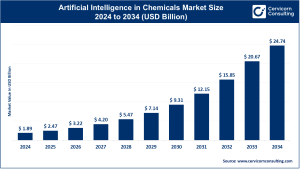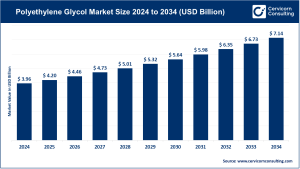Polysilicon Market Overview
The global polysilicon market plays a pivotal role in powering the renewable energy and semiconductor industries. Polysilicon—also known as polycrystalline silicon—is a purified silicon material that serves as a fundamental input in the production of solar photovoltaic (PV) cells and semiconductor devices. In 2024, the market reached a valuation of USD 41.97 billion and is projected to grow significantly to nearly USD 155.87 billion by 2034, advancing at a CAGR of 14.30%. Growth momentum is strongly supported by the global shift toward solar energy adoption, continuous improvements in solar cell technology, and favorable government frameworks aimed at boosting clean energy initiatives.
Key Market Trends
-
Technological Advancements in Solar Cells
Breakthroughs such as Passivated Emitter Rear Cell (PERC) and bifacial modules have enhanced solar cell efficiency, creating a stronger need for ultra-high-purity polysilicon to support superior energy conversion. -
Eco-Friendly Production Practices
Manufacturers are focusing on sustainable and low-energy production techniques, including fluidized bed reactor technology, to reduce emissions and align with carbon neutrality goals. -
Vertical Integration of Major Players
Global leaders like Tongwei Group and OCI COMPANY Ltd. are streamlining operations across the solar value chain, from polysilicon to modules, ensuring cost efficiency and supply stability. -
Emergence of Regional Production Hubs
While China dominates the market, new hubs are emerging in India, the Middle East, and Southeast Asia as governments aim to strengthen domestic solar capacity. -
Policy Support and Incentives
Financial incentives, renewable energy targets, and tax benefits continue to encourage solar deployment, driving greater polysilicon demand worldwide.
Market Drivers
-
Rising Global Demand for Solar Power
Solar PV installations are expanding rapidly due to falling module costs, especially across developing economies, directly spurring polysilicon consumption. -
Innovation in Manufacturing
Technological progress in semiconductors and solar cells requires increasingly pure polysilicon to achieve higher performance standards. -
Government Backing
Policy frameworks such as the U.S. Inflation Reduction Act and the European Green Deal are encouraging investment in renewable infrastructure and domestic polysilicon production. -
Energy Demand from Emerging Markets
Industrialization and urbanization in regions like India, Brazil, and Southeast Asia are boosting electricity consumption, creating opportunities for large-scale solar adoption.
Impact of Trends and Drivers
-
Regional Perspective:
-
China remains the largest producer with strong domestic consumption.
-
Middle Eastern nations are investing heavily in renewable energy projects, with large-scale polysilicon facilities like those in Qatar.
-
Europe is increasing local production to enhance energy security.
-
Asia-Pacific beyond China, particularly India, is growing as a new hub supported by subsidies and clean energy goals.
-
-
Segment Perspective:
The solar PV sector accounts for the bulk of demand, while the semiconductor industry represents a smaller but higher-value market that requires ultra-pure grades. -
Supply Chain Perspective:
Vertical integration and adoption of energy-efficient production methods are helping stabilize supply and reduce costs for end users.
Challenges & Opportunities
-
Challenges:
-
High energy intensity in production.
-
Geopolitical risks such as U.S.–China trade disputes.
-
Volatile raw material pricing.
-
-
Opportunities:
-
Accelerating global transition to clean energy.
-
Expansion of advanced solar technologies like bifacial modules.
-
Strategic investments in low-carbon production methods and geographic diversification.
-
Future Outlook
The polysilicon market is on track for robust growth, driven by innovations in high-efficiency solar modules, the push toward sustainable production, and expanding manufacturing bases across emerging economies. As clean energy adoption accelerates globally, polysilicon will remain indispensable in supporting both the renewable energy transformation and advancements in semiconductor technology.
👉 Contact Us for a Detailed Overview: Cervicorn Consulting

